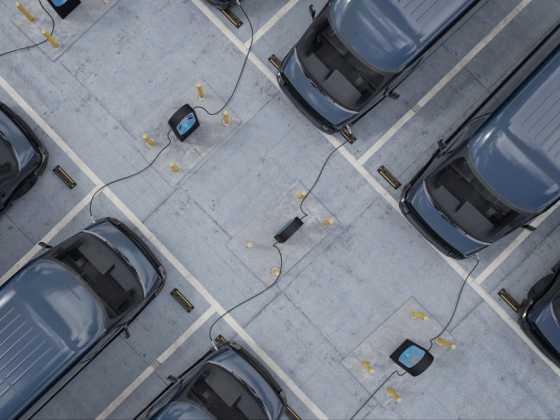Exploring fleet decarbonisation challenges

A mix of fleets attended the latest GreenFleet Roundtable at Ashton Gate Football Stadium in Bristol to discuss their progress towards decarbonisation, as well as the barriers that remain
On 19 May at Ashton Gate Football Stadium in Bristol, GreenFleet was joined by a mix of public sector fleets, including police, fire and defence services, as well as council fleets and waste management. The University of the West of England, the Environment Agency and Bristol Airport were also present.
Almost unanimously, the fleets in attendance are facing a number of challenges around HGVs and specialist vehicles, vehicle availability, electrical network upgrades and remuneration of employee charging.
The roundtable was also attended by Ashley Tate, founder and CEO of Mina – a mobility solution provider that specialises in access and payment solutions for public, work and home charging.
Lower maintenance costs offer a big TCO benefit
The early adopting fleets have seen some big benefits from electrification, particularly fleets that are predominantly passenger vehicles.
The Environment Agency has already achieved circa 25 per cent electrification (BEV and PHEV) and aims to be fully zero emission (passenger vehicles) by 2025.
Gloucestershire Constabulary has reached the 20 per cent mark for full battery electric vehicles alone. Both fleets report seeing big savings on maintenance.
DEFRA reports a 30 per cent reduction and servicing and maintenance costs, and Steve Imm (Gloucestershire Const) has been able to reduce the maintenance team by one full headcount (through attrition).
Some factors remain out of the control of fleets
Our fleets reported that vehicle availability, particularly vans, remains a challenge. To mitigate the constrained supply of low emission vehicles, Dale Enyon, fleet director at DEFRA has placed a series of bulk orders. He observed that the supply chain is “lumpy” with no visibility of delivery dates, and vehicles arriving in small batches. But with a large fleet of 4,500 vehicles, the vehicles are easily placed.
Many of our roundtable participants operate HGV and specialist vehicles. And there was a good discussion on the merits of electric versis hydrogen for N2 and N3 vehicles. Brian Robinson, commercial vehicle & sustainability consultant for Zemo partnership was on hand to address these questions and stressed that the market for fully electric HGVs was emerging quickly. Upfront costs remain a big barrier for these vehicles with a premium of over £200k on the larger vehicles; there was strong agreement that stronger Government grants were needed to support the emerging battery electric truck market. One solution to the high total cost of ownership (TCO) for electric HGVs was to amortise the cost of the vehicle over a longer period; given the absence of moving parts and lower vibration Brian suggested that 12 years is not unrealistic.
HVO was also a popular solution in the short to medium term, and Zemo’s Renewable Fuel Assurance Scheme was signposted
Reimbursement is administration heavy
The majority of fleets that operate company cars reported using the AER rate for the reimbursement of electricity costs. However there are many issues with this; depending on where the employee has charged (home or public charging) the rates vary from as little as 5p per kWh for charging at home off peak to 55p+ per kWh for using a public rapid charge network. The efficiency of the vehicle (miles per kWh) also varies according to the size and weight of the vehicle. Another very important consideration is that the employee (who receives the reimbursement in their pay packet) may not be responsible for paying the electricity bill.
It is little wonder that many fleets are opting to work with Mina; CEO Ashley Tate provided an overview of their EV charging access and payment solution that ensures employees are reimbursed the exact cost of charging. The Chargepass card provides access to 7,100 public charge points and all costs are invoiced direct to the employer.
Mina also offers a highly innovative reimbursement scheme for home charging where the cost of electricity is paid direct to the electricity company – ensuring there this is no “bill shock” at the end of the quarter, or when the direct debit is reviewed, and removing the administrative burden from the fleet manager.
Electrical upgrades are becoming reality
Both Bristol Airport and Cherwell District Council (CDC) are in the process of upgrading the incoming supply to site with the local Distribution Network Operator (DNO). Bristol Airport is in the middle of a strategic upgrade (8MW) to allow for growth of the airport as well as accommodating the electrification of airside, supplier, customer and employee vehicles (they have over 14,000 parking spaces).
CDC is upgrading their Banbury Depot to 1000 kVa, however, CDC’s Bicester depot is not suitable for a DNO upgrade and relocation of the depot is under consideration.
Free charging for employees will not last forever
The question of how much employee parking needs to be dedicated to EV Charging (and when) was a keen topic. The general feeling was that 20 per cent of parking seemed high, although this is likely to be inevitable in the medium term. Three of our fleets reported that employees currently have free access to workplace charging, although both DEFRA and Gloucestershire Constabulary are reviewing this policy due to the increasing costs.
Surrey County Council currently charge 33p per kWh (in line with other public charging AC networks).
Encouragingly the choice of solutions for billing employees for the cost of electricity is increasing and Mina is on hand to support this process.






